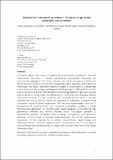| dc.contributor.author | Aejmelaeus-Lindström, Petrus | |
| dc.contributor.author | Willmann, Jan | |
| dc.contributor.author | Tibbits, Skylar | |
| dc.contributor.author | Gramazio, Fabio | |
| dc.contributor.author | Kohler, Matthias | |
| dc.date.accessioned | 2016-06-22T20:00:34Z | |
| dc.date.available | 2017-03-01T16:14:47Z | |
| dc.date.issued | 2016-04 | |
| dc.date.submitted | 2015-09 | |
| dc.identifier.issn | 1434-5021 | |
| dc.identifier.issn | 1434-7636 | |
| dc.identifier.uri | http://hdl.handle.net/1721.1/103279 | |
| dc.description.abstract | This paper takes a first step in characterizing a novel field of research-jammed architectural structures-where load-bearing architectural structures are automatically aggregated from bulk material. Initiated by the group of Gramazio Kohler Research at ETH Zürich and the Self-Assembly Lab at Massachusetts Institute of Technology, this digital fabrication approach fosters a combination of cutting-edge robotic fabrication technology and low-grade building material, shifting the focus from precise assembly of known parts towards controlled aggregation of granular material such as gravel or rocks. Since the structures in this process are produced without additional formwork, are fully reversible, and are produced from local or recycled materials, this pursuit offers a radical new approach to sustainable, economical and structurally sound building construction. The resulting morphologies allow for a convergence of novel aesthetic and structural capabilities, enabling a locally differentiated aggregation of material under digital guidance, and featuring high geometrical flexibility and minimal material waste. This paper considers (1) fundamental research parameters such as design computation and fabrication methods, (2) first results of physical experimentation, and (3) the architectural implications of this research for a unified, material-driven digital design and fabrication process. Full-scale experimentation demonstrates that it is possible to erect building-sized structures that are larger than the work-envelope of the digital fabrication setup. | en_US |
| dc.publisher | Springer Berlin Heidelberg | en_US |
| dc.relation.isversionof | http://dx.doi.org/10.1007/s10035-016-0628-y | en_US |
| dc.rights | Article is made available in accordance with the publisher's policy and may be subject to US copyright law. Please refer to the publisher's site for terms of use. | en_US |
| dc.source | Springer Berlin Heidelberg | en_US |
| dc.title | Jammed architectural structures: towards large-scale reversible construction | en_US |
| dc.type | Article | en_US |
| dc.identifier.citation | Aejmelaeus-Lindström, Petrus; Jan Willmann, Skylar Tibbits, Fabio Gramazio, and Matthias Kohler. "Jammed architectural structures: towards large-scale reversible construction." Granular Matter 18:28 (2016), pp. 2-12. | en_US |
| dc.contributor.department | Massachusetts Institute of Technology. Department of Architecture | en_US |
| dc.contributor.department | Massachusetts Institute of Technology. Self-Assembly Lab | en_US |
| dc.contributor.mitauthor | Tibbits, Skylar | en_US |
| dc.relation.journal | Granular Matter | en_US |
| dc.eprint.version | Author's final manuscript | en_US |
| dc.type.uri | http://purl.org/eprint/type/JournalArticle | en_US |
| eprint.status | http://purl.org/eprint/status/PeerReviewed | en_US |
| dc.date.updated | 2016-05-31T12:13:21Z | |
| dc.language.rfc3066 | en | |
| dc.rights.holder | Springer-Verlag Berlin Heidelberg | |
| dspace.orderedauthors | Aejmelaeus-Lindström, Petrus; Willmann, Jan; Tibbits, Skylar; Gramazio, Fabio; Kohler, Matthias | en_US |
| dspace.embargo.terms | N | en |
| mit.license | PUBLISHER_POLICY | en_US |
